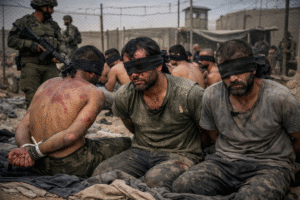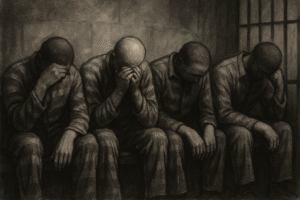Since the beginning of its occupation of Palestine in 1948, Israel has established dozens of prisons, investigation centers, and detention facilities, many of which are supervised by the army. Thousands of Palestinian prisoners and detainees are held in them annually under inhumane conditions, subjected to killing, torture, and humiliation.
According to United Nations figures and official Palestinian estimates, more than one million Palestinians have been detained in Israeli prisons since 1967, including tens of thousands of children.
The Israeli human rights organization “B’Tselem” issued a report in August 2024 describing the inhumane conditions endured by more than 10,000 Palestinians in Israeli detention centers, suffering from violence, torture, and humiliation. The report was titled “Welcome to Hell.”
Dirty and Overcrowded Cells
Most Palestinian detainees live in dirty, overcrowded cells that far exceed their capacity, without the provision of necessary supplies and conditions suitable for human life.
According to international organization reports and human rights associations, Israeli prison administrations commit blatant violations, including frequent and arbitrary acts of severe violence, sexual assaults, and detainees are subjected to humiliation and degradation and are prohibited from practicing their religious rituals.
Israeli prison administrations also deprive Palestinian detainees of sleep, food, water, and medical treatment. They may obstruct visits by international and human rights organizations to some prisons and prevent detainees’ families from visiting or contacting them for prolonged periods.
History of Israeli Detention Facilities
The history of Israeli prisons dates back to the large field detention camps set up by Zionist gangs during their military operations in Palestinian villages and towns, which began in early 1948 and continued after the establishment of the occupying state in May of the same year.
During 1948 and 1949, the Zionist gangs—and later the Israeli army—detained thousands of Palestinians who refused displacement, including children, women, and the elderly, and threw them into temporary collective camps surrounded by barbed wire or held them in police stations or prisons inherited from the British Mandate.
A group of temporary detention centers became notorious at the time, such as Sarafand and Haifa Detention Center, located in the Hadar neighborhood atop Mount Carmel slopes, which became a source of terror for Palestinians.
The detainees were later transferred from temporary camps to central detention facilities, supervised by members of the Irgun, Stern, and Haganah gangs, where they were subjected to various forms of abuse, torture, starvation, and even deportation orders or executions without charges or trials.
Israel exploited British camps and detention centers it seized after Britain withdrew from Palestine, such as Atlit Detention Center and Sarafand Labor Camp. It also established new detention centers such as Ijlil Detention Center and Umm Khaled Labor Camp.
Recognition of the Detention Centers
At the time, Israel recognized four detention centers, which it allowed the International Committee of the Red Cross to visit in early 1949. It classified the detainees as prisoners of war, although the Red Cross reported that most detainees were farmers from Galilee villages, not combatants.
During that period, Israel designated, through military decisions and political support, a number of camps used as “labor centers” or “forced labor camps” where Palestinian detainees were compelled to work in Israeli production facilities, especially in hard labor such as stone quarries, construction, and excavation, serving military and economic institutions.
In his book The Ethnic Cleansing of Palestine, Israeli historian Ilan Pappé mentioned that Israeli detention camps during that period held about 9,000 Palestinians, most of them male villagers between the ages of 10 and 50.
Establishment of the Israeli Prison Service
In 1949, the Israeli Prison Service was established, and it built new permanent prisons while simultaneously closing temporary ones such as Ijlil, Atlit, Sarafand, and Umm Khaled.
The prison construction movement halted during the 1950s until 1966. During this time, the Israeli authorities imposed a military government on Palestinian villages occupied in 1948, turning those areas into massive collective detention camps. Movement out of villages required a permit from the military governor, and a nighttime curfew was imposed.
Israeli Prisons after the Naksa
Following Israel’s occupation of the West Bank, Gaza Strip, Sinai Peninsula, and the Syrian Golan Heights in the June 1967 war, resistance activities escalated. Israel opened several prisons, such as Ashkelon Prison and Be’er Sheva Prison, to suppress activists and eliminate resistance.
It also set up two secret detention and exile camps in Sinai, one of which was Nahal Detention Camp, established in 1968, where hundreds of young men from Gaza aged between 18 and 30 were detained.
Israel later claimed it had imprisoned unemployed people from Gaza there on the grounds that they were vulnerable to joining militant groups, stating that the aim was to provide them vocational training in construction and later push them to move to the West Bank.
The second was Abu Zenima Camp, established in 1970 in southern Sinai, where Israel detained the families of Gaza fighters to pressure wanted individuals and suppress resistance. A total of 26 families were exiled there, including dozens of children and women. One of the exiled families had 59 members.
No official statistics were released about the number of detainees or information related to these camps until their closure in 1973. Years later, Israeli media revealed some data about the two camps.
To accommodate the growing number of detainees, Israel established new camps in 1970 and 1971, such as Qasima Detention Camp, Wadi Musa (Tur) Detention Camp, Saint Catherine Detention Camp, and Arish Detention Camp. All were closed in 1973.
New Prisons to Suppress Resistance
Wars waged by Israel were always linked to the establishment of new detention centers, such as during the invasion of Lebanon in 1982, the various wars on Gaza, and the intensification of Palestinian resistance in the West Bank during the First Intifada in 1987 and the Second Intifada in 2000. Prisons were opened to detain tens of thousands of fighters and civilians.
In 1982, when Israel invaded Lebanon, it established Ansar Detention Camp in the town of Ansar in southern Lebanon, which the Israeli army called “Mikhlet Ansar” or “Ansar Cattle Pen,” where 4,700 Palestinians and Arabs were detained. They were all released in a prisoner exchange deal in 1983.
The camp consisted of hundreds of tents in the open air, surrounded by barbed wire without any basic human dignity requirements. Between 10,000 and 15,000 detainees passed through the camp over three years. They were subjected to various forms of torture, abuse, and death-inducing treatment until the camp was fully closed in 1985.
In 1984, Ansar 2 Camp was established on Gaza’s beachfront, where hundreds of young men from Gaza and university students who had participated in mass protests were detained. It was closed a year later and reopened after the 1987 Intifada.
Israel established dozens of detention centers and central prisons in Gaza and the West Bank, such as Gaza Central Prison, Ramallah Central Prison, Hebron Central Prison, Nablus Central Prison, Junaid Prison, Jenin Central Prison, Tulkarem Central Prison, Far’a Detention Center, Dhahiriya Detention Center, and Anata Detention Center.
In the 1990s, these prisons were closed following peace agreements and the Oslo Accords. The Palestinian Authority assumed governance in the West Bank and Gaza, many Palestinian prisoners were released, and those who remained in custody were transferred to Israeli prisons inside the 1948 occupied territories.
Other Israeli prisons were closed for various reasons. Karmel (Atlit) Prison was shut down in 2010 after severe fires. Sarafand Military Prison was closed in 2015 to convert the site into a residential area.
Central Prisons, Detention, and Interrogation Centers
Israel established three types of detention facilities:
Type 1: Detention Centers
Usually located within military facilities or settlements and used to hold detainees pending trial. Key centers include:
- Huwara Camp near Nablus
- Beit El Center southeast of Ramallah
- Etzion Center near Bethlehem
- Kedumim Center in Tulkarem
- Salem Center northwest of Jenin
- Kfar Yona (Beit Lid) Detention Camp between Tulkarem and Netanya
Type 2: Interrogation Centers
Dedicated to interrogating Palestinian detainees before trial, including: Kishon, Al-Maskobiya, and Petah Tikva.
Type 3: Central Prisons and Detention Camps
Israel has established about 20 of these, holding thousands of Palestinian prisoners annually. Notable examples include:
- Gilboa Prison: Opened in 2004 in the Beit She’an area, northern Israel.
- Ashkelon Central Prison: Former British military base and reception center. Converted to a prison in 1970. Known for the brutal “honor walk” between two rows of guards beating detainees with batons.
- Ayalon Prison (Ramla): Built by Britain in 1934, used by the Israeli army starting in 1953. Became a central prison in 1967. A women’s section, Neve Tirza, was added in 1968. In 1978, the Nitzan wing was added.
- Be’er Sheva Central Prison: Established in 1970 with four separate prisons, including Ohalei Kedar and Eshel for Palestinian security prisoners.
- Nafha Prison: Built in 1980 in the Negev desert. One section houses Palestinian leaders under heavy security, subject to solitary confinement and abuse.
- Negev Detention Camp (Ansar 3): Opened in 1988 near the Egyptian border. Held around 50,000 Palestinians before its temporary closure in 1995. Reopened in 2000 during the Second Intifada and became a central prison in 2005.
- Shata Prison: Located in the Beit She’an Valley. Secured with 7-meter-high walls, barbed wire, and watchtowers. Holds Jerusalem and 1948 Palestinian detainees.
- Megiddo Prison: Opened in 1988 for Palestinian security detainees. Was under military control until 2003.
- Hadarim Prison: Modern American-style facility, opened a section for Palestinian detainees in 1999.
- Ofer Prison: Built during the British Mandate in Beitunia near Ramallah. Turned into a detention camp during “Operation Defensive Shield” in 2002. Permanent buildings replaced tents after 2005.
- Damon Prison: Located in the Carmel Forest, Haifa. Former British warehouse, converted into a prison in 2000 during the Second Intifada.
- Secret Prison 1391: Israel denies its existence, lists it as fields/hills on maps. Located in a central Israeli kibbutz. Detainees subjected to degrading and inhumane treatment. International bodies are barred from visiting.
- Sde Teiman Detention Center: Built by the British in the Negev, seized by Israel in 1948. Used as a military base and known for receiving Yemeni Jews between 1949–1951. Converted to a prison during the 2008–2009, 2014, and October 2023 Gaza wars. Composed of tin and zinc shacks; detainees suffer from violence, abuse, including torture and sexual assaults.
Gilboa Prison (again listed): Known for its high security—9-meter walls topped with coated metal that can’t be climbed, and anti-tunneling materials under the floor. Holds dozens of Palestinians classified by Israel as “the most dangerous.” Famous for a 2021 prison break by six detainees.





